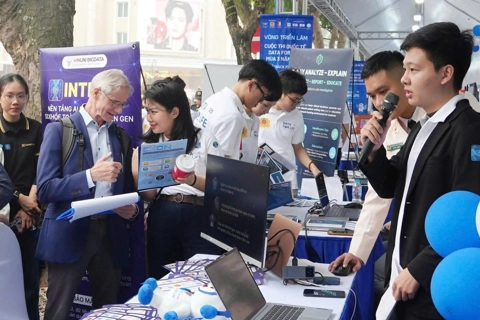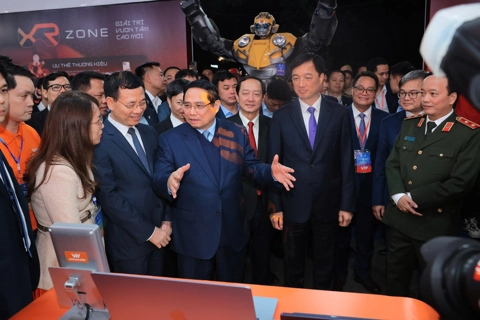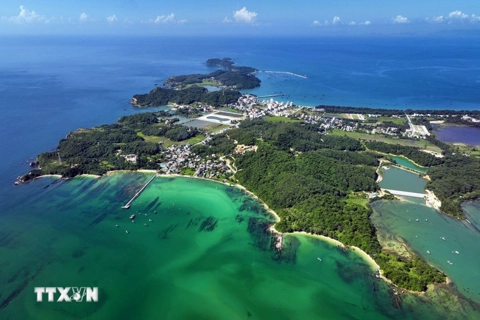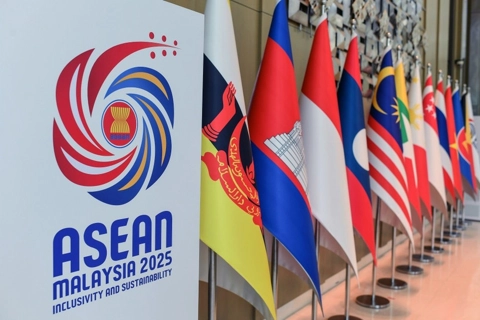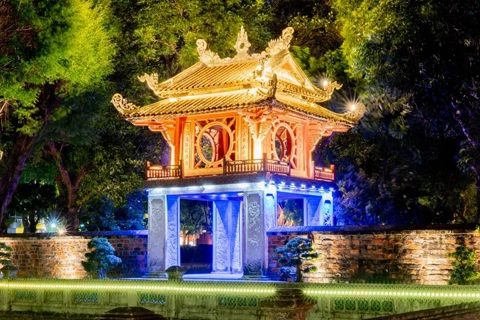Vietnam
China’s unacceptable greed with the East Sea
Jun 23, 2014 / 02:49 PM
The legal ramifications and motivation for China’s illegal placement of its oil rig Haiyang Shiyou-981 in the East Sea was the topic that captured major attention of international and Vietnamese scholars.
Judging from any legal angle, the stationing of the drilling platform 981 by China is illegal. This view was shared by scholars attending a discussion on China’s wrongdoings in Vietnam's waters as part of a recent international conference on the Hoang Sa (Paracel) and Truong Sa (Spratly) archipelagos held in Danang.

According to scholars, based on the coordinates reported by the Chinese State administrative department in charge of maritime affairs, the location where the Chinese oil rig is operating entirely lies deep in Vietnam’s exclusive economic zone and continental shelf.
China’s unilateral placement in this area is not in line with the regulations of international law.
Speakers agreed that the Hoang Sa (Paracel) Islands are a disputed territory and China's claim of sovereignty over the Paracel that is not in dispute is unacceptable.
China’s attempt to change the status quo is a violation of international law and the Declaration on the Conduct of Parties in the East Sea (DOC) that China signed with ASEAN in 2002.
On the basis of international law, the 1982 UN Convention on the Law of the Sea (UNCLOS), the speakers pointed out the absurdities in China's argument on its deployment of its floating oil rig.
Regarding the operational location of the drilling as near an adjacent area of the Paracel Islands by China is unacceptable, they noted.
On the other hand, the Chinese drawing of the position of the rig 981 on the map of “Nine-dash” line shows ambiguity in the Chinese claims in the East Sea. China regarding the position of its oilrig operating in the waters of Tri Ton island represents double standards in water claims over marine structures because China sees Japan's Shima Okinotori island as just rocks with water areas up to 12 nautical miles.
China's view on the waters where its oil rig is operating is also inconsistent as at first, it announced the territorial area belongs to the Tri Ton island, and after that this area is considered an adjacent area of the Tri Ton island.
Professor Jerome Cohen from New York University’s School of Law said that even if the Hoang Sa(Paracel) archipelago belongs to China (the reality is not so), islands of Hoang Sa cannot be located in an vast sea area as they are opposite to the very long coast of Vietnam.
To solve the problem of Chinese obstinate intention not to withdraw its oil rig and escort ships from Vietnam’s waters and sit for negotiations with Vietnam, speakers said that the best solution for the time being is the use of legal measures and mechanisms of international jurisdiction.
First, it is essential to demand China comply with international law and related agencies resolve international disputes. On the basis of international law, particularly the 1982 UNCLOS, Vietnam can sue China in terms of a number of issues such as the effect of the islands, obligation to reach temporary agreements in disputed areas, violations in maritime security, safety and freedom.
At the meeting, scholars gave in-depth analyses on the Chinese scheme, describing it as a new escalation in order to legalize “Nine-dash” line and monopolize the East Sea.
China’s illegal act broke the status quo in the East Sea, threatening peace, stability, security, safety and freedom of navigation in the region.
They suggested that Vietnam should refer to experience from the Philippines in the use of legal measures.
The speakers said that the placement by China of the drilling platform is aimed at taking full control of the East Sea. Chinese controlling Scarbourgh shoal of the Philippines in 2012 and the East of " Nine-dash” line and the stationing of oil rig 981 in western “Nine dash” line and its repeated military exercises in the southernmost point of the "Nine dash” line, have clearly demonstrated China's goal of gradual realization of “U-shaped” line.
China’s illegal actions have escalated tensions in the East Sea, negatively impacting the Vietnam-China relationship.
Many speakers praised Vietnam’s efforts and goodwill for peaceful settlement of conflicts, stating that the country should continue to enlist the support from the international community in this regard so as to create pressure on China and prevent it from conducting new actions of escalation.
China’s unilateral placement in this area is not in line with the regulations of international law.
Speakers agreed that the Hoang Sa (Paracel) Islands are a disputed territory and China's claim of sovereignty over the Paracel that is not in dispute is unacceptable.
China’s attempt to change the status quo is a violation of international law and the Declaration on the Conduct of Parties in the East Sea (DOC) that China signed with ASEAN in 2002.
On the basis of international law, the 1982 UN Convention on the Law of the Sea (UNCLOS), the speakers pointed out the absurdities in China's argument on its deployment of its floating oil rig.
Regarding the operational location of the drilling as near an adjacent area of the Paracel Islands by China is unacceptable, they noted.
On the other hand, the Chinese drawing of the position of the rig 981 on the map of “Nine-dash” line shows ambiguity in the Chinese claims in the East Sea. China regarding the position of its oilrig operating in the waters of Tri Ton island represents double standards in water claims over marine structures because China sees Japan's Shima Okinotori island as just rocks with water areas up to 12 nautical miles.
China's view on the waters where its oil rig is operating is also inconsistent as at first, it announced the territorial area belongs to the Tri Ton island, and after that this area is considered an adjacent area of the Tri Ton island.
Professor Jerome Cohen from New York University’s School of Law said that even if the Hoang Sa(Paracel) archipelago belongs to China (the reality is not so), islands of Hoang Sa cannot be located in an vast sea area as they are opposite to the very long coast of Vietnam.
To solve the problem of Chinese obstinate intention not to withdraw its oil rig and escort ships from Vietnam’s waters and sit for negotiations with Vietnam, speakers said that the best solution for the time being is the use of legal measures and mechanisms of international jurisdiction.
First, it is essential to demand China comply with international law and related agencies resolve international disputes. On the basis of international law, particularly the 1982 UNCLOS, Vietnam can sue China in terms of a number of issues such as the effect of the islands, obligation to reach temporary agreements in disputed areas, violations in maritime security, safety and freedom.
At the meeting, scholars gave in-depth analyses on the Chinese scheme, describing it as a new escalation in order to legalize “Nine-dash” line and monopolize the East Sea.
China’s illegal act broke the status quo in the East Sea, threatening peace, stability, security, safety and freedom of navigation in the region.
They suggested that Vietnam should refer to experience from the Philippines in the use of legal measures.
The speakers said that the placement by China of the drilling platform is aimed at taking full control of the East Sea. Chinese controlling Scarbourgh shoal of the Philippines in 2012 and the East of " Nine-dash” line and the stationing of oil rig 981 in western “Nine dash” line and its repeated military exercises in the southernmost point of the "Nine dash” line, have clearly demonstrated China's goal of gradual realization of “U-shaped” line.
China’s illegal actions have escalated tensions in the East Sea, negatively impacting the Vietnam-China relationship.
Many speakers praised Vietnam’s efforts and goodwill for peaceful settlement of conflicts, stating that the country should continue to enlist the support from the international community in this regard so as to create pressure on China and prevent it from conducting new actions of escalation.



